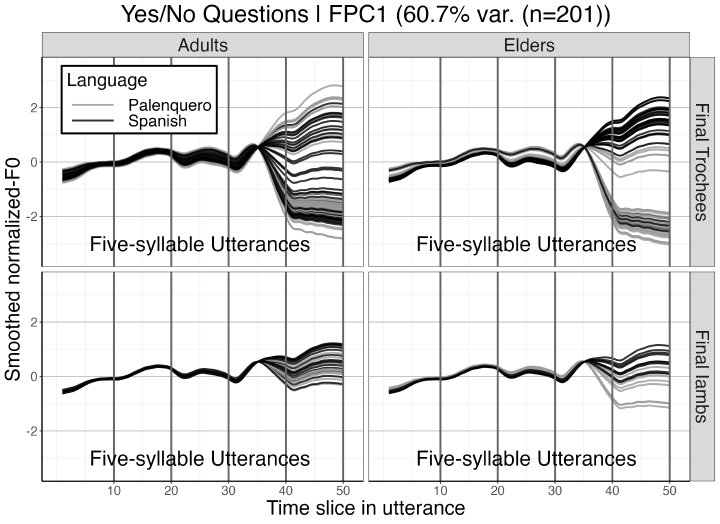Age effects and language differentiation for yes/no question intonation in two groups of Palenquero/Spanish bilinguals
 Image credit: ggplot2
Image credit: ggplot2
Abstract
Palenquero is an Afro-Hispanic creole language which is being revitalized since the early 1990s. Fluent speakers of Palenquero avoided its use, and did not transmit it to their children, due to the stigma associated with the creole. Those former children are now adults, and are also the architects of an extraordinary revival program for the creole. They are heritage speakers of Palenquero, and have additionally learned the creole in school. Thus, Palenquero/Spanish bilinguals speak both a European majority language, and an Afro-Hispanic creole which still preserves some of the phonotactic restrictions of their African ancestors. Previous studies have suggested that these bilinguals use penultimate lengthening language-specifically, as it seems to be less frequently used in Spanish statements (Correa, 2017). The present study aims to determine to what extent two groups of bilinguals, adult and elderly speakers, keep their Palenquero and Spanish prosodically distinct for yes/no questions, a previously unstudied sentence type. Ten Palenquero/Spanish bilinguals participated in two unilingual discourse completion tasks, eliciting 230 yes/no questions containing segmental strings of five syllables. Penultimate lengthening was tested with linear mixed-effects models predicting vowel length in final trochees and iambs, from both adult and elderly bilinguals. Language-specific intonation was also explored on dimensionally-reduced F0 contours, using Functional Principal Component Analysis, while final stress, language, and generational effects were assessed on each F0 dimension, using linear mixed-effects models. Results demonstrate that adult bilinguals tended to adapt boundary tones to the stress pattern of the final word. They produced L% for trochees, but tended to truncate this boundary tone for questions ending in iambs (see Fig.1). On the other hand, the elderly bilinguals tended to produce boundary tones for yes-no questions in a language specific way, L% in Palenquero and H% in Spanish, regardless of the stress pattern on the final word. Adults appear to behave in a way similar to other Spanish varieties in the Caribbean. The elderly, in contrast, have consistently used L% in Palenquero, and this does not seem to be sensitive to the stress pattern. Conversely, Spanish yes/no questions tend to end in a high, plateau-like tone. One explanation for this is that the elderly speakers have overgeneralized the truncation rule followed by the adults (and shown in other Spanish varieties) so that all yes/no questions end in a “truncated” way. This phenomenon has been shown for toddlers acquiring Puerto Rican Spanish, which has variable truncation for their ¡H* L% nuclear configuration, and the L% tone is often (but not always) truncated. In language contact, overgeneralization might be connected to the imperfect group learning that non-native speakers may reveal during the process of language shift.